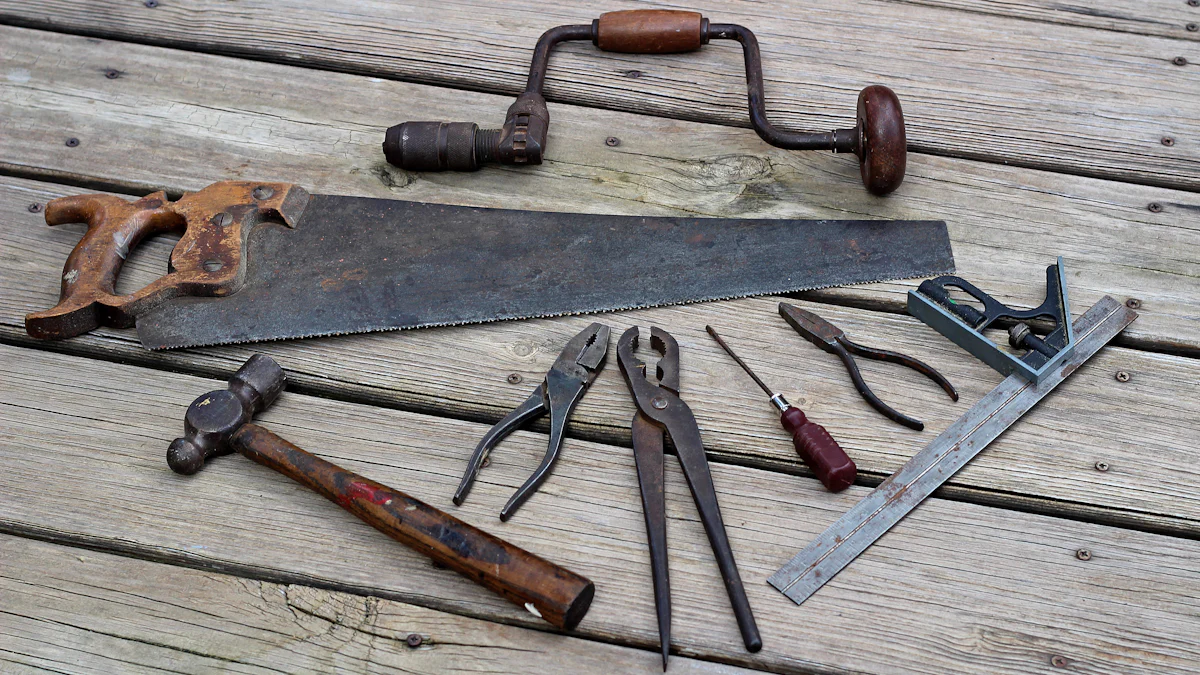 Antique hand tools captivate collectors with their tangible link to the past, showcasing remarkable human craftsmanship and innovation. Understanding the antique hand tools value is crucial for enthusiasts seeking to delve into this intriguing world. Factors like rarity, condition, and historical significance greatly influence the worth of these treasures, ranging from a few hundred dollars to significant sums at auctions.
Antique hand tools captivate collectors with their tangible link to the past, showcasing remarkable human craftsmanship and innovation. Understanding the antique hand tools value is crucial for enthusiasts seeking to delve into this intriguing world. Factors like rarity, condition, and historical significance greatly influence the worth of these treasures, ranging from a few hundred dollars to significant sums at auctions.
Factors Influencing Value
When assessing the antique hand tools value, collectors are drawn to the element of Rarity. As Mike Jenkins, an Antique Tool Collector, aptly puts it, rarity significantly enhances a tool’s worth. For instance, if a renowned company like Stanley produced a limited quantity of a particular tool, such as tool number 5,000, its scarcity in today’s market elevates its value. The allure of owning a piece that is not easily found adds a layer of exclusivity and desirability.
Within the realm of rarity lies the concept of Limited Production. Tools that were not mass-produced but rather had a restricted manufacturing run tend to hold more value due to their scarcity. These limited-edition pieces become coveted items among collectors who appreciate the uniqueness and historical significance they represent.
Another pivotal factor influencing the value of antique hand tools is their Unique Features. Hand drills, for example, come in various shapes and styles, each embodying distinct characteristics that contribute to their value. Collectors often seek out tools with exceptional features or made from rare materials as they add an extra layer of intrigue and collectibility.
Moving on to the aspect of Condition, collectors pay close attention to details like Wear and Tear. The patina on an old tool tells a story of its past use and adds character to the piece. When examining wear patterns and signs of age, enthusiasts can gauge the authenticity and history behind each tool.
Furthermore, the impact of Restoration on a tool’s condition cannot be overlooked. While some collectors prefer tools in their original state with signs of age intact, others appreciate expert restoration work that enhances both aesthetics and functionality.
Delving into the realm of Historical Significance, collectors often seek out tools with a distinctive Maker’s Mark. These marks not only authenticate the origin but also provide insights into the craftsmanship and legacy of the maker. Additionally, tools associated with significant Historical Events or periods carry added value due to their connection to specific moments in time.
In essence, understanding these factors – rarity, condition, unique features, maker’s mark, historical events – is paramount when evaluating antique hand tools’ worth in today’s vibrant collector’s market.
Identifying Valuable Tools
Antique hand tools hold a distinct allure for collectors, with their tangible connection to history and craftsmanship. When seeking to identify valuable tools, enthusiasts often focus on specific Physical Characteristics that set these treasures apart.
Physical Characteristics
Worn Wood
Antique hand tools crafted from worn wood bear the marks of time, showcasing the years of dedicated use and craftsmanship embedded in each grain. The aged appearance of wooden handles or components adds a sense of authenticity and nostalgia to the tool, resonating with collectors who appreciate the stories these weathered surfaces tell.
Cast Iron
In the realm of antique hand tools, cast iron components play a crucial role in determining value and authenticity. Tools featuring cast iron parts exhibit durability and precision craftsmanship characteristic of bygone eras. Collectors value these sturdy pieces not only for their functionality but also for their historical significance and enduring appeal.
Authenticity Verification
Hand-Finished Surfaces
One key aspect of identifying valuable antique hand tools lies in examining the presence of hand-finished surfaces. These meticulous details reflect the artisanal touch of skilled craftsmen from earlier times, adding a layer of artistry and quality to each tool. Collectors seek out tools with carefully finished surfaces as they signify superior workmanship and attention to detail.
Tool Marks
Another essential element in verifying the authenticity of antique hand tools is scrutinizing the presence of distinctive tool marks. These unique imprints left by craftsmen serve as signatures of individual makers or workshops, offering insights into the tool’s origin and provenance. By studying these marks closely, collectors can unravel the history behind each tool and appreciate its place in the narrative of craftsmanship.
In essence, recognizing valuable antique hand tools involves a keen eye for physical attributes like worn wood and cast iron components, coupled with an appreciation for intricate details such as hand-finished surfaces and distinctive tool marks. By delving into these characteristics, collectors can uncover hidden gems that embody both historical significance and enduring value in today’s vibrant collector’s market.
Market Trends
Antique hand tools, steeped in history and craftsmanship, continue to command attention in the vibrant collector’s market. The realm of Market Trends offers insights into the dynamic landscape of auctions and evolving collector preferences.
Auction Insights
High-Value Sales
- Exceptional antique hand tools often spark intense bidding wars at auctions, leading to high-value sales that surpass initial estimates.
- Collectors fervently compete to acquire rare pieces with unique features, driving prices to remarkable heights and setting new benchmarks in the market.
- The allure of owning a coveted tool with historical significance propels enthusiasts to invest substantially in these prized possessions.
Bidding Dynamics
- Auctions serve as platforms where collectors showcase their passion for antique hand tools through strategic bidding dynamics that reflect their dedication to the craft.
- The competitive nature of auctions fuels excitement among participants, creating an atmosphere where each bid contributes to the narrative of value and desirability.
- Understanding the nuances of bidding dynamics is essential for collectors aiming to secure valuable tools and navigate the exhilarating world of auction acquisitions.
Collector Preferences
Popular Tool Types
- Among collector preferences, certain tool types stand out as perennial favorites due to their timeless appeal and functional versatility.
- Tools like vintage planes, saws, levels, wrenches, and rules capture the interest of enthusiasts seeking both practical utility and historical significance.
- The enduring popularity of these classic tool types reflects a deep appreciation for traditional craftsmanship and design excellence.
Emerging Trends
- In a landscape shaped by innovation and evolving tastes, emerging trends offer glimpses into the future direction of antique hand tool collecting.
- Contemporary collectors are increasingly drawn to specialized tools or unique variations that showcase inventive features or artistic embellishments.
- Keeping abreast of emerging trends enables enthusiasts to stay ahead in a dynamic market environment and anticipate exciting opportunities for expanding their collections.
In essence, staying attuned to market trends provides collectors with valuable insights into auction dynamics, popular tool types, and emerging trends that shape the ever-evolving world of antique hand tool appreciation.
- Understanding the market trends and future prospects in the Hand Tools industry is crucial for companies to comprehend market movements, strategize effectively, and gain a competitive edge.
- Reversible restoration techniques in woodworking and tool restoration are essential as they allow for adaptation to future technological advancements without irreversible changes.
- Tracking technology advancements is paramount for the tool industry to stay abreast of innovations and maintain relevance in a dynamic market environment.
